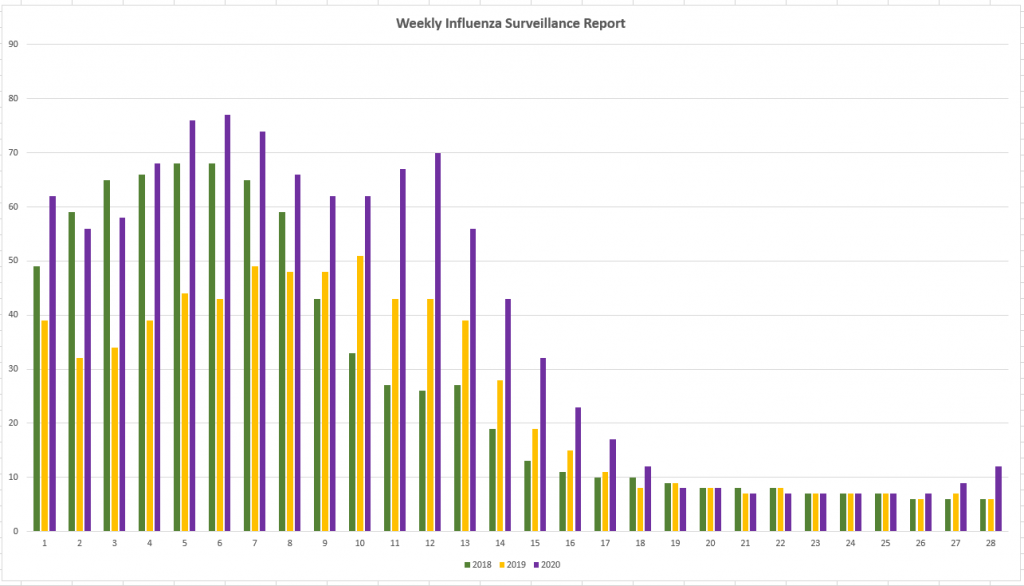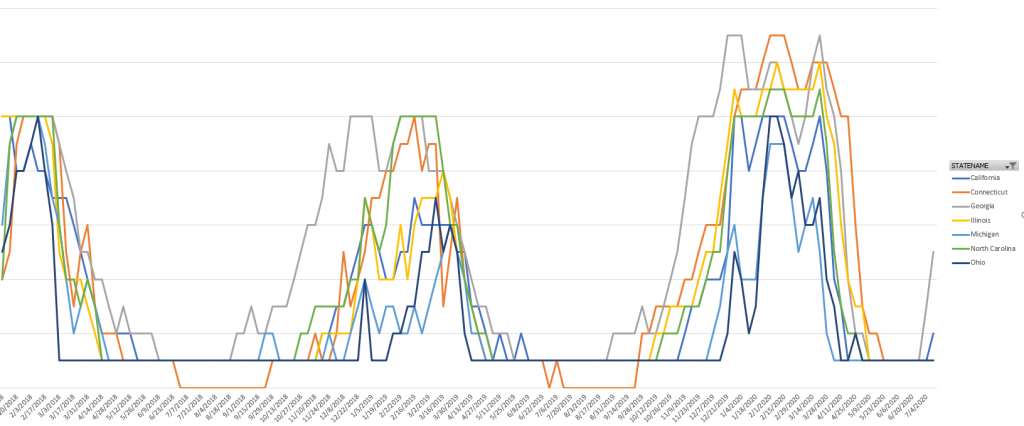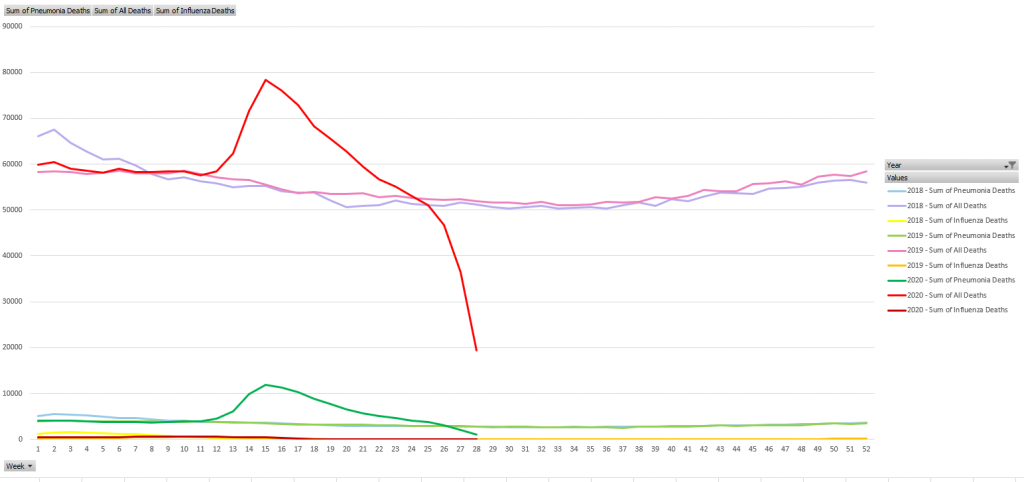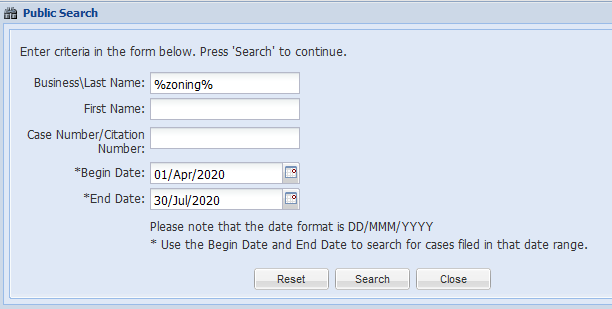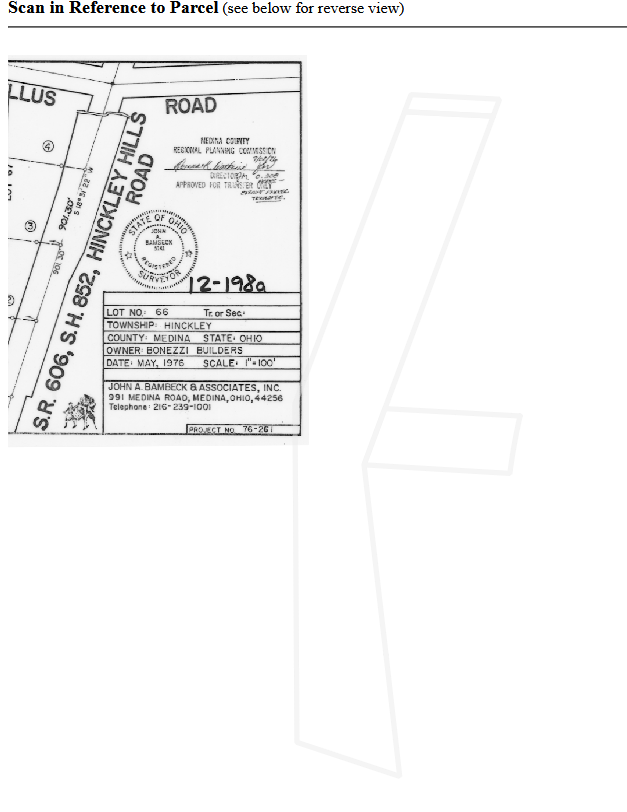Since my website has a lot of information about Microsoft Teams, I can see when a lot of new Teams users came online during the lockdown. Now that people are returning to offices (and, I expect, are more familiar with the platform), I’m starting to see fewer search engine referrals. But I’m still 3-4x the numbers I’d seen pre-lockdown.
Category: Miscellaneous
The Proliferation of Misinformation
A friend mentioned that Madonna has jumped on the demon-sperm-doctor’s ‘a cure exists’ train. To which someone replied “who cares?” … which is a reasonable gut reaction. Some celebrity, or has-been celebrity, wants to walk around telling everyone they need to get Airpods? I don’t care.
I don’t care that one individual believes, well, any crackpot idea or conspiracy theory either. There was a guy in downtown Philly who walked around with a sign declaring that the alien invasion was nigh and we should save ourselves by … I don’t even remember what he thought would appease our future alien overlords. People generally ignored him or felt sorry for him. Sometimes gave him a hairy eyeball. And we all carried on.
When the crazy idea is picked up by more individuals? Nonsense is less objectionable when a lot of people believe it (i.e. there are people who read this doctor’s statements from the fifth source & think maybe it’s true).
When those who hold sway over a lot of other people start promoting disinformation? Some percentage of Trump’s 84.3 million followers, and some percentage of Madonna’s 2.6 million followers, take this seriously. They use the ‘information’ to justify mask refusal, heading out to parties, etc. Unless you’re completely off the grid, you’ll be sharing space with them at some point. That’s why I care.
Grown Up Temper Tantrums
Death Panels
Texas is going to start sending the least likely to survive home to free up healthcare resources. A few months back, Italy had been floating some metrics for determining who got sent home and who rcv’d treatment. Had a few friends freaked out over the inhumanity of it, but … there’s a limited resource exceeded by need (and a metric may make it easier for healthcare workers charged with delivering awful news to families). To act like the choice is between this awful scenario and something awesome — like we could have this most-apt-to-survive-gets-treatment rule or everyone would immediately be treated (successfully, of course) for whatever ailment — is living in a fantasy world.
Those aren’t the choices available. What we’ve got without “least likely to survive get no treatment” seems to be either first-come-first-serve or highest-bidder. Neither of those are great algorithms for determining who is saved. A “death panel” sounds inhumane (and it’s obviously branding from an opposition group), but some outcome prediction to determine who gets treated … well, I guess it sucks for those with unlimited cash to ensure they’re always going to be the high bidder because they’ve now in the same boat as everyone else. But it’s about as close to an equitable solution as you can get in an awful situation.
One of my biggest problems with politics is the short-attention-span theatrics of it all. Both death panels and now — yeah, someone can come up with a terrifying phrase to make a solution sound unthinkable. But talk about the options and the rational for the approach for an hour and it’s a different picture.
I wish progressives would get better at branding and marketing — yeah, we’ve got death panels. But you’ve got the medical treatment auctioneer. This vial of insulin goes to the highest bidder — and Anne Rice wins this round. Sorry, all you penniless rubes. If you’re not in a coma in two hours, we’ll have another auction.
Hopefully people will be a little more understanding of treatment allocation based on predicted outcomes next time we talk about universal healthcare.
Influenza Data
Scott hypothesized that 2020 should have a fairly low rate of illness apart from SARS-CoV-2. The preventative measures taken to limit the spread of this virus should also have reduced the number of people with colds, flu, etc. There’s no way to tell for mild illnesses, but I knew the CDC tracked flu and pneumonia cases … you can link the CDC’s CSV data sources into Excel, create a Pivot table to get rows of week numbers or months & columns of year-by-year case counts, then create a chart that compares case counts year-to-year. Unfortunately, they have a new file name each week. You’ve got to find the latest URL from https://www.cdc.gov/flu/weekly/index.htm
I was surprised to see 2020 significantly higher than the previous two years through the end of April and bumping back up again between weeks 26 and 27 (late June / early July)
Broken out by state and filtered to a few states to make the chart readable, I see the same trend. 2020 is generally higher than 2019 or 2018.
The significant increase in pneumonia deaths this year? That’s probably not people who actually had pneumonia completely unrelated to SARS-CoV-2. The influenza/pneumonia data set includes an “All Deaths” column — which depicts the excess deaths for 2020 (I assume the past month or so of data is not yet finalized, as thee numbers fall off sharply in the final weeks of the data set).
Medina County Court of Common Pleas – iJEMS Wildcard Search
You can perform wildcard searches in iJEMS — to find all of the cases in the Medina County Court of Common Pleas that include zoning in the last name/business field, use the following search:
Mid-stream
Statistical Coverup
Zoning Variance Request – Reduced Setbacks
There is a prospective buyer who has requested a variance to the township’s setback requirements in order to build his house on a neighboring property. The zoning requirements stipulate a 120′ front setback from the center-line of the private right-of-way (i.e. the park’s road) and a 50′ rear setback from our property. The original request cited a 90′ front setback based on a public right-of-way, but that is not correct. While the request states he wants to reduce the front setback by 40′ and the rear setback by 34′, I think the actual request on the front setback is 70′.
There are a few justifications provided for the setback request — that there are technical limitations that mandate the variance, that the elevation means the property won’t bother the neighbors, that the previous zoning would have allowed construction within these bounds, and neighboring properties have similar encroachments.
While we are not trying to create a hardship for the buyer, we were given notice of a public hearing and told it was the time to state our opinion. When we were shopping for a house, we specifically wanted to live in a rural environment. When I consider the use and enjoyment of one’s property, consideration is not limited to the structures erected on the property. We specifically wanted to purchase several acres of land with wooded areas because hiking in the woods is an enjoyable activity.
Hinckley’s Master Policy Plan highlights the community’s desire “to protect and promote the rural and natural character of the Township”. This is not a new initiative in Hinckley, the 2003 Master Policy Plan speaks to preserving “the existing rural character and image of the township”. Part of our house shopping process included reviewing zoning regulations — we wanted to maintain a large garden and possibly raise farm animals. And we didn’t want to learn after purchasing a home that we were legally precluded from using the property as we desired. One of the attractive things about Hinckley was the large minimum lot sizes and expansive setback requirements.
Technical Limitations — To me, a technical limitation of a lot would be where a combination of zoning regulations preclude building on the property. As an example, after accounting for setback requirements, the smaller non-conforming lots may not have enough buildable land to construct a home with the minimum floor area requirements with two off-street parking spaces. It may not be possible to build a compliant home on a two acre lot, once elevation and waterways are considered.
In this case, there is land available for the footprint of the structure. One of the things I would like to see during the site review is the dimension of the land deemed buildable. The fact a particular home design does not fit on a lot is not a technical limitation of the lot. It is reality. There are millions of other homes, of similar size and with similar features, which could be built on the lot and fully comply with the zoning regulations.
Elevation — While the structure in question may be 30+ feet in elevation over the park’s road, carpark, and hiking trail, it is not 30′ in elevation over the woods where we hike.
Non-conforming Lot Setbacks — Section 4.1.G stipulates minimum side and rear yard depths for R1 and R2 District lots covered in the “Substandard Lot Provisions”. Section 6R1.4.K lists three sub-standard lot minimum lot areas: 32,670 sq ft (0.75 acre); 66,000 sq ft (~1.52 acres); 65,340 sq ft (1.5 acres). The lots, as previously platted, were each under 0.75 acres. Survey Book 39, page 212 contained the “current” platting prior to the lots being combined. Lot A is 0.4947 acres, lot B 0.4707 acres, lot C 0.4780 acres, and lot D 0.4960 acres. As such, it was my understanding that anyone who desired to build on one of the lots would require a variance due to the lot size — which would allow us the opportunity to review and comment on the proposed structure.
Additionally, the fact that a structure could have been build with a fifteen foot rear setback on each of the previously existing lots is a specious argument. This isn’t a non-conforming lot. The property owner voluntarily combined the four sub-standard lots into one standard lot. This included adding formerly unowned property under Bellus Road. If the desire was to build within the allowable parameters of a sub-standard lot, then the lots should have remained sub-standard.
Setback of Other Neighboring Properties — The closeness of neighboring properties was one of the few negative points about our property — walking around the kitchen patio feels walking in the neighbor’s back yard. Walking from our back yard along the South side of the property feels like walking in the neighbor’s side yard.
The other houses in the neighborhood are well over fifteen feet from their rear property lines. These measurements (1) assume decks, patios, and above-ground pools are not used in determining setback distances and (2) estimates based on the aerials from the Medina County Engineer’s GIS system. About 20′ of our house is about 25′ from the property line. Because the Medina County Engineer’s GIS system has the aerial OSIP (Ohio Statewide Imagery Program) tiles and parcel lines misaligned, the house appeared to be about 45′ from the property line. It wasn’t until we’d lived here for a year or two that Scott and a friend searched out the property pins and we realized the line was really close to the house.
Z’s garage is about 40′ from the property line. Greg and Erica’s house is over 50′ from the rear property line with an accessory building very close to the property line. Larry’s house is over 50′ from the rear property line, although the rear deck and pool and accessory building are quite close to the property line. Mark and Rae’s is over 50′. Cynthia’s house is well over 50′, but there is an accessory building situated near the property line. Side lot setbacks are certainly not in compliance with zoning standards for two acre lots, but all of these lots are well under two acres
But, of the six houses in the neighborhood, half were built more than 50 years ago. Two of the remaining three were built 30 years ago, and the newest house was built 20 years ago. I do not know what the zoning regulations contained decades ago (i.e. these may well have been compliant at the time), and the older houses may well predate zoning regulations. Even if the zoning regulations were exactly the same at the time, we didn’t participate in the variance discussion because we didn’t live here. For half of the properties, we weren’t even born.
| Owner | Street Number | Year Built | Years Ago |
| Z | 1830 West Dr | 2000 | 20 |
| Greg & Erika | 1850 West Dr | 1953 | 67 |
| Larry | 1860 West Dr | 1990 | 30 |
| Mark & Rae | 1870 West Dr | 1961 | 59 |
| Cynthia | 1886 West Dr | 1940 | 80 |
| Scott & Lisa | 1006 Bellus Rd | 1990 | 30 |
Something’s existence does not make more of it desirable. There is traffic on Bellus Rd, but having Center Rd rerouted to our street while the bridge was under construction was disruptive.
The variance process is not a common-law system — a variance being issued in once circumstance does not set a precedent that requires similar variances be issued.
Medina County: Finding Survey, Deed, and Permit Info
I had downloaded some PDF files of the county survey books after we first bought our house. We wanted a little more info, but were completely unable to find where I’d gotten the survey book pages. Fortunately, a very helpful individual at the County Recorders office knew what I had and exactly how to get there. Figured I’d write it down for the next time we want to pull up survey information. The trick is to not use the new Medina County GIS website.
From http://engineer.medinaco.org, select “Traditional” from the GIS menu. This will bring you to the old county GIS interface at http://engineer.medinaco.org/cgi-bin/mchequery.cgi
From the drop-down menu hidden between the red bar and an text input and select a search type (Parcel Number, Address, Owner Last Name)

Click Query/Refresh

You will now see information about the searched parcel and a map. Scroll down.

From here, you can access a bunch of different information – for the survey books, select “Scans”.

There’s a lot of information available. In the Surveys, there’s a cool feature — the top part of the page contains a portion of the document and a light gray outline showing the searched parcel — when you cannot figure out why a particular page shows up when your parcel isn’t involved — look for a tiny portion of your parcel that’s technically on the page. In this example, a few feet of our lot appear under the information block. There are a few pages where the little section of land on the public right-of-way appear somewhere along the bottom portion of a scan. I expect they’ve got the corners of each page tagged with geographic information & your scan query retrieves anything where any of your lot falls within those bounds. Survey and tax map go back over a hundred years, and it’s neat to see how the property lines have changed (and not changed). Plus, I now know Bellus Rd was named after the family that owned the farm across the street from us.
Since I’m writing down where I’ve found important documentation … I’ll add:
Building permits are available through the Medina County Building Department at https://medina.onlama.com/Default.aspx
Deed transfers, mortgage instruments, etc are available through the Medina County Recorder at http://recordersearch.co.medina.oh.us/OHMedina/AvaWeb/#!/search

